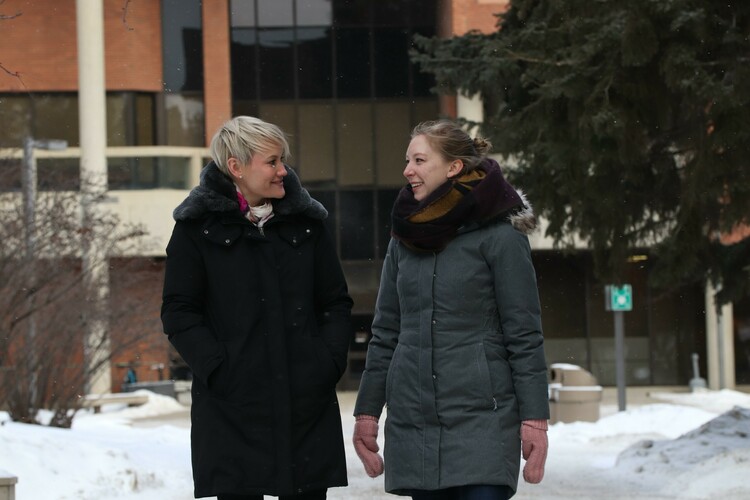Collaborative co-design could be key to better environmental decision-making: study
Posted on
Kylie (left) and Maggie (right) are exploring how methods of engagement effect wetlands project outcomes.
More communicative public engagement style on complex environmental issues leads to best outcomes when science, economics, and social factors are all weighed
It’s not just what experts say, it’s how they say it. And sometimes, it’s not about the experts at all - it’s who else is talking about it, and what they’re saying.
New research from UAlberta’s School of Business is showing that methods of engagement could have major impacts when planning new environmental initiatives around the province.
Under the supervision of Professor Dev Jennings, Business PhD students Kylie Heales and Maggie Cascadden are demonstrating that the style of public consultation in complex environmental issues is critical to determining successful outcomes. They hope their work will lead to more productive discussions between industries, governments, and communities.
In their work, town-hall style consultations, consisting of a lecture followed by time for questions from the audience, were compared to a small-group, round-table style discussion. “The main difference is the degree of collaboration between the participants," Cascadden explained. "The information we delivered was the same."
Unlike the town-hall style, the round-table format supports collaborative co-design of the project or process being presented. "Including science, business, and community members in the design process goes well beyond most versions of town-hall consultation," Heales added. "We were interested to see how it affects three outcomes - environmental, economic, and social.”
The topic of discussion was how to pursue building constructed wetlands to clean oil sands process water in areas disturbed by energy projects. Cascadden and Heales presented four potential scenarios, representing different approaches to maintenance and intervention. To ensure accuracy, the scenarios were designed around elements of ongoing reclamation research at the University of Alberta, with collaboration from UAlberta professors Mohamad Gamal El-Din and Anne Naeth. After being presented with the options, participants were asked to choose which options they believed to be most effective and preferred, and, in some cases, design their own wetland.
“The question is whether the method of engagement would affect the scientific decision - would they choose a better option based on how they were engaged,” Heales said.
When considering all measured outcomes, they found that the collaborative engagement style led to cumulative results across environmental, economic and social outcomes that were frequently better than town-hall style. While economic outcomes played a large role, the biggest influence was social drivers - measuring feelings of procedural justice, trust, and cohesion in the group.
“With the collaborative style, people talked to each other, and it seemed to lead them to better believe in the process,” Cascadden said.
“With any type of public engagement, you typically have people walking in with more dispersed values and attitudes,” Heales added, “and this style of collaborative and informed engagement might help mitigate some of the associated conflict.”
The benefit of better social outcomes could be far-reaching, including more committed support of the wetland project, many of which require long-term interventions, and long term relationships with the communities around them.
More specifically, Heales and Cascadden see increased cohesion as a way to prevent opposing factions from forming, which could turn the focus from the environmental issue at hand to an ‘us-vs-them’ standoff. Likewise, a better sense of procedural justice could support ongoing community involvement and support of future environmental initiatives.
Both researchers see the limitations of their work - small, controlled experiments based on theoretical plans. They hope to address some of those concerns in their next step, looking at examples of constructed wetlands and reclamation of natural resource project sites around Alberta to expand from the theoretical to the practical.
“We’ve identified some constructed wetlands built with experimental engineering processes,” Heales said. “They seem to have achieved multiple good outcomes, and we’re interested in getting to those sites and determining what worked.” Examining real field sites in the next phase of the study should provide better insight into what a successful process and result could look like for other wetlands.
“People need to have trust in the system,” Heales said. “Democracy matters, and what happens after a democratic event, like public consultation, matters too. That’s why the process of engagement is important.”
----------------------------------------------
To learn more about this work, click here.